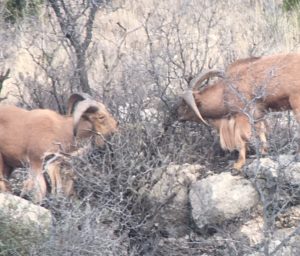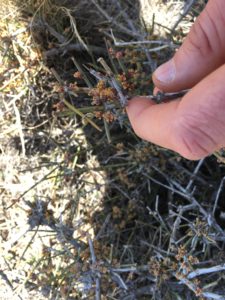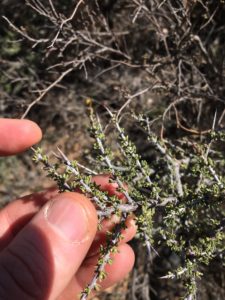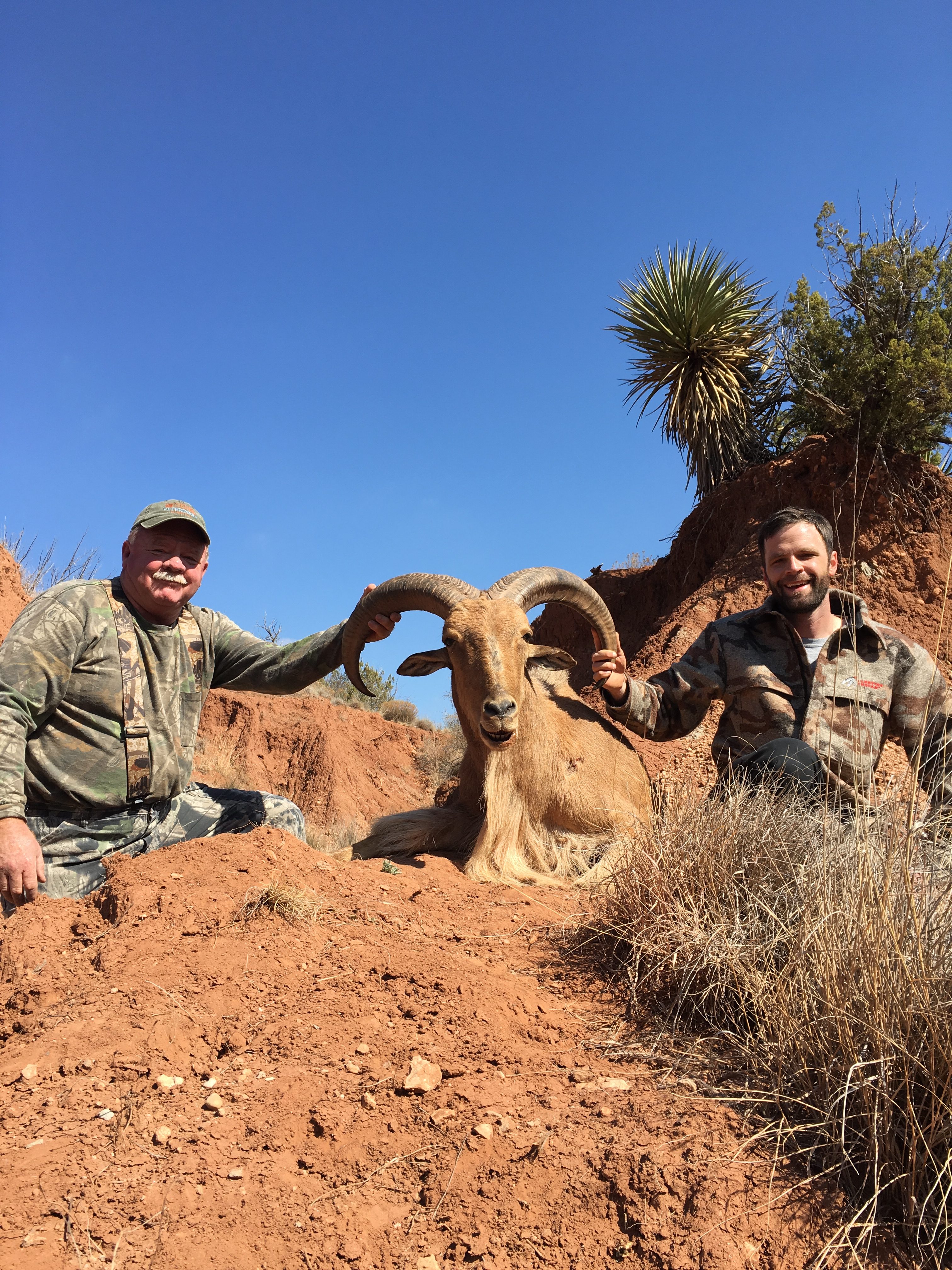This article is one of many from our Aoudad Prep Series
*Much of the information in this article is based on discussions with life-long aoudad guides and academic studies like this one.
Background of Barbary Sheep in Texas
Barbary sheep were introduced in New Mexico during the 1950s by the New Mexico Fish and Game Department. They made several reintroductions across the state with the intention of introducing a huntable species in habitat that other game was not utilizing. A private ranch, Hondo Valley, also made its own reintroduction that later resulted in the establishment of aoudad in the national parks along the Texas/NM border. In a separate reintroduction effort, 44 sheep were reintroduced into the Palo Duro Canyon (North Texas) in 1957.
This historical evidence does align with a viewpoint many guides have always had on aoudad genetics. There are genetic differences between the New Mexico, Texas Panhandle and Far West Texas Sheep; cape color, horn structure, and body size.
Fish and game departments also attempted to reintroduce other native species over this time like mule deer and turkeys. These species did not do as well as the Barbary Sheep.
Aoudad were protected by agreement with ranchers/farmers during the ten year period after their reintroduction. By the 1970s there were abundant aoudad hunting opportunities.
Habitat and Food
One of the most contentious issues regarding aoudad is that they key in on many of the same browse species that our native big game animals focus on. If it looks like good muley country or bighorn browse, the aoudad will love it. Mountain Mohagany (Alder leaf type – Common in Texas Panhandle) and other low browse brush is their favorite food source. I have also noticed that they key in on Morman Tea and Javilina Bush. They will pick at Mesquite and eat the common grasses of Texas.

Barbary Rams Browsing Mesquite and the Under Growth Browse
Aoudad have thrived over their native competition in part because they will also feed on other, lower quality feed. This includes junipers and yucca.

Heavily Browsed Morman Tea
Aoudad are consistent throughout the year in terms of the topography they like. They prefer rugged terrain, particularly canyon/rimrock/caprock structure with multiple benches above a floor. In areas they are commonly hunted in or have natural predators, the sheep most commonly occupy the bench structures 2-3 levels up. These areas are the most inaccessible areas on the structures to predators and humans. The sheep will feed on flats and go to water/feed in the bottoms, but they prefer to spend most of their time in the cliffs. It is amazing how little water aoudad need to survive.

Javilina Bush
Like mountain goats, large solo rams and mature bachelor groups tend to stay in the toughest terrain. Females with young will commonly use the canyon rims to hide their young while they feed in the flats. However, on ranches that receive little hunting pressure, I have seen trophy caliber rams that rarely leave the bottoms and first layer of caprock benches.
The Aoudad Rut and Seasonal Behavior
Aoudad can and will breed anytime of the year. However, over 70% of births take place March/April. This means that, regardless of what folks theorize, there is an “Rut” during the months of October and November.
I personally have never seen Barbary rams fight with the intensity of bighorns, but some observations by biologists claim that they will engage in head butting at high velocity. Most of the behavior I have seen is more akin to mountain goat male-on-male behavior; hooking, slow moving butting, pushing with shoulders, side butting, etc… It is rare to see a harvested older age-class aoudad ram with chips, so I can’t imagine full blown bighornesque fights are common in the geographies we hunt.
Most studies indicate a small segment of births occurring that indicate a “second-rut” in February/March.
The majority of the year, Barbary sheep spend their time in groups similar to the other species we hunt. Three types of groups prevail: nursery groups of ewes, lambs and subadult males; bachelor groups of mature rams, and solo mature rams. The solo mature rams are the ones to blame for the aoudad’s ability to colonize new territory. Rams have been observed moving 50-80 miles from their original home range. Nursery groups and bachelor groups, to a lesser extent, stick to a small home range. Most studies indicate a range of 1.5 to 6.5 square miles. This is another area where aoudad are a lot like mountain goats. Any group larger than 1-4 males, sticks to a small home range.
During the winter and early spring, aoudad are found in larger groups. Part of this concentration is due to the rut during Oct/Nov, but it is likely exacerbated because sheep concentrate on readily available food sources on canyon flats and bottoms as the winter progresses. Bachelor groups are disbanded during the rut and slowly reform to large groups by January and later.
Big Rams
It takes a long time to grow big aoudad rams. Most trophies are 9-13 years old. With basic population dynamic estimates, birth rates, annual mortality rates, etc… it takes a population of 100-200+ ewes to consistently produce one trophy ram each year. In areas of extreme productivity and low mortality, this might be cut down to 80-100+ productive ewes. That’s a lot of sheep on the landscape!
Like mountain goats and bighorns, aoudad rams grow the vast majority of their horn length early in their life. Rams will have 22″+ horns by the age of 3.5 and 27-28″ horns by 6.5 years of age. For extensive field judging, checkout this article I wrote.
Aoudad do not broom their horns and they do have annual growth rings that are set each fall/rut. These rings are more difficult to see than on mountain goats or bighorns. It is best to count them from the “inside” of the horn’s curve.
Large rams can weigh around 350lbs. Some West Texas rams do exist close to 400lbs.
Hunting Strategy
Aoudad hunting is a prototypical spot and stalk, western style hunt. The landscape and species lend well to this type of hunting.
The majority of hunting done in Texas takes part during January through March. The sheep are concentrated during this time, making them easier to glass. There is no doubt that this timing is best for seeing a high number of sheep. Hunts usually consist of glassing from vehicle and short hike accessible vantage points.
The other reason the January-March time frame is focused on in Texas is because the native hunting seasons are over. I believe this is why the October/November/December hunts are overlooked. We offer some great hunts in early December in Far West Texas that produce monster rams during this time. The rams are just off the rut and some of the rams that spend the rest of the year solo are still accessible. This time of year you have to be even more diligent when it comes to glassing, as the sheep are more dispersed.
The glassing/stalking approach can be physically demanding in aoudad terrain. Hence, as an alternative strategy, we can sit on flats or bottoms until sunset to catch sheep as they leave their rugged terrain.
Sign up to get our new posts as they are published!



Hello Cliff. I am headed to NM for an Aoudad hunt next week. The temps are forecast to be pretty cold. Do Aoudad move or sit tight in weather like that?
Any info would be helpful.
Thank you and Happy New Year to y’all!
Hi Andy,
I apologize I was so slow to reply. I was on a lion hunt. Unlike elk/deer, I find that aoudad don’t move much in cold weather until the sun hits them. A lot of the time I glass along the line of light on the landscape as the sun rises. A lot of the time sheep will standup and move to a rock our clearing just as the sun hits them. Hope your hunt went well!
Cliff
Cliff,
I am hunting west of Fort Worth, Tx this coming week on a friends property. I have never hunted Audad, but want to see how it goes. We are going to bow hunt. Any advice specifically for bow hunting this guys?
How skittish Aoudad are varies a lot on where they are. Generally they are really wary, and tough to bow hunt… great eyesight, etc… However, if they don’t get hunted a lot or are habituated to humans (oil and gas workers, traffic on roads) they can be a lot easier to bow hunt. A lot of the time rams move up terrain through specific saddles or chutes. A good time to harvest them with a bow is in those areas, as they travel up to bed. Good luck!
If they are in a high fence over a feeder, they aren’t much different than any other high fenced game animal… perhaps a little less patternable and consistent on coming in.
First I’d like to say thanks for these articles, well written and tons of great info, your efforts are greatly appreciated. I was drawn for the NM “rut hunt” down in 29&30 in mid Oct this year, from a purely numbers standpoint it appears as this is the most desirable Barbary hunt in the state (lowest draw odds and highest harvest rate), would you agree? Do you believe that hunting them during the rut will provide any more/better opportunities than hunting them outside of the rut? I noticed you guys don’t typically hunt them at this time of year and your articles don’t have much rut info so I wanted to ask if you have any other tips/suggestions for hunting them during this time frame. Thanks again,
Mike
Hi Mike, unfortunately I am not an expert on the NM units. It sounds like you have a good tag.
I personally don’t think that most aoudad herds have a super defined rut like other species. I see a huge variation in the size/age the the kids during the early Spring, telling me that breeding isn’t that concentrated.
I’d say that there is some marginal better opportunity during the Oct-Nov rut, because the bigger rams do seem to be with or near the nursery groups. Those groups are easier to find than the bachelor groups of rams.
Cliff. Kenny here. I live in Kansas and are looking for a DIY hunt for aoudad. any ideas? Thanks
Hey Kenny,
Not a ton of experience with DIY aoudad hunts. There are several folks that hunt hard in NM OTC and draw areas. I notice that a few, dedicated guys achieve the vast majority of the success. This tells me that it isn’t easy and takes a lot of time/dedication. Akin to OTC elk hunting in Colorado – 5% of the hunters do all the killing.
You might try some pay-to-access DIY options down around the Big Bend/Alpine areas of Texas. Google and you will find a few options that seem reasonable. Don’t expect an easy hunt or big rams, but I bet aoudad are of decent density on most those places.
Hope that helps,
Cliff